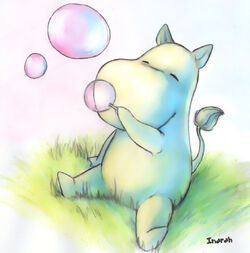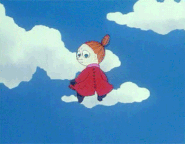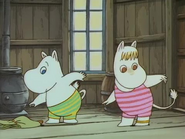
The Moomins are the central characters in a series of books and a comic strip by Finnish illustrator and writer Tove Jansson, originally published in Swedish by Schildts (and later in Finnish by WSOY) in Finland. They are a family of trolls who are white and roundish, with large snouts that make them resemble hippopotamuses. The carefree and adventurous family live in their house in Moominvalley, in the forests of Finland, though in the past their temporary residences have included a lighthouse and a theatre. They have many adventures along with their various friends.
In all, nine books were released in the series, with five picture books and a comic strip also written by Jansson being released between 1945 and 1993.
The Moomins have since been the basis for numerous television series, films and even a permanent museum exhibition and a theme park in Finland.
Synopsis and Characters[]
The Moomin stories concern several eccentric and oddly-shaped characters, some of whom are related to each other. The characters' differences are accepted and their needs are accommodated. The central family consists of Moominpappa, Moominmamma and Moomintroll. Other characters, such as Hemulens, Sniff, The Snork maiden,Snufkin and Little My are accepted into or attach themselves into the family group from time to time.
The series is set in the fictional Moominvalley. It is here that the Moomin family decide to live at the end of The Moomins and the Great Flood, where they live in the Moominhouse.
Biographical interpretation[]
Critics have interpreted various Moomin characters as being inspired by real people, especially close family members of the author. In interviews, Tove Jansson has also spoken openly about the backgrounds of and possible models for her characters.
The life partner of Tove Jansson was the graphic artist Tuulikki Pietilä, whose personality inspired the character Too-Ticky in Moominland Midwinter.Moomintroll and Little My have been seen as psychological self-portraits of the artist. The Moomins, generally speaking, relate strongly to Jansson's own family — they were bohemian, lived close to nature and were very tolerant towards diversity. Moominpappa and Moominmamma are often seen as portraits of Jansson's parents Viktor Jansson and Signe Hammarsten-Jansson. Some of Jansson's characters are on the verge of melancholy, such as the always formal Hemulen, or the strange Hattifatteners who travel in concerted, ominous groups. Jansson uses the differences between the characters philosophies to provide a venue for her satirical impulses. The novelist Alison Lurie has described the Groke, a black, hill-shaped creation with glowing eyes, as a walking manifestation of Nordic gloominess – everyone she touches dies, and the ground freezes everywhere she sits.
The Moomin stories have a very humane message. The books have caprices and utterances which ponder life and ways of the world. Snufkin comments on freedom: "One can never be entirely free, if one admires someone else too much." Little My expresses possession: "Possession means worries and luggage bags one has to drag along."
List of books[]
The books in the series, in order, are:
- The Moomins and the Great Flood (Originally: Småtrollen och den stora översvämningen) - 1945.
- Comet in Moominland, Some editions: The Happy Moomins - (Originally: Kometjakten/Kometen kommer) - 1946.
- Finn Family Moomintroll (Originally: Trollkarlens hatt) - 1948.
- The Exploits of Moominpappa, Some editions: Moominpappa's Memoirs (Originally: Muminpappans bravader/Muminpappans memoarer) - 1950.
- Moominsummer Madness (Originally: Farlig midsommar) - 1954.
- Moominland Midwinter (Originally: Trollvinter) - 1957.
- Tales from Moominvalley (Originally: Det osynliga barnet) - 1962 (Short stories).
- Moominpappa at Sea (Originally: Pappan och havet) - 1965.
- Moominvalley in November (Originally: Sent i november) - 1970 (In which the Moomin family is absent).
The first book, known in English as The Moomins and the Great Flood (Originally: Småtrollen och den stora översvämningen) was finally published in English in 2005 (though only in Finland).
There are also five Moomin picture books by Tove Jansson:
- The Book about Moomin, Mymble and Little My (Originally: Hur gick det sen) - 1952.
- Who Will Comfort Toffle? (Originally: Vem ska trösta knyttet) - 1960.
- The Dangerous Journey (Originally: Den farliga resan) - 1977.
- An Unwanted Guest (Originally: Skurken i Muminhuset) - 1980 (No English translation published, although an unofficial translation is available online).
- Songs from Moominvalley (Originally: Visor från Mumindalen) - 1993 (No English translation published).
The books and comic strips have been translated from their original Swedish and English into many languages.
The comic strip[]
The Moomins also appeared in the form of comic strips; their first appearance to a big audience was in the popular London newspaper The Evening News in 1954, in English. Tove Jansson drew and wrote all the strips until 1959. She shared the work load with her brother Lars Jansson until 1961; after that he took over the job until 1975 when the last strip was released.
Drawn and Quarterly, a Canadian graphic novel publisher, is releasing a new reprint series of The Evening Newsstrips, beginning in October 2006. The first three volumes of Moomin: The Complete Tove Jansson Comic Strip are currently available, with two more volumes planned to follow.
In the 1990s, a comic book version of Moomin was produced in Scandinavia after Dennis Livson and Lars Jansson's animated series was shown on television. Neither Tove nor Lars Jansson had any involvement in these comic books; however, in the wake of the series, two new Moomin comic strips were launched under the artistic and content oversight of Lars and his daughter, Sophia Jansson-Zambra. Sophia now provides sole oversight for the strips.
Adaptations[]
TV series and movies[]
The story of the Moomins has been made into television series on many occasions by various groups, the most recent of which is a Japanese-Dutch collaboration that has also produced a feature-length movie. However, there are also two Soviet series, puppet animation Mumi-troll (Moomin-troll) and cutout animation Shlyapa Volshebnika(Magician's hat) of three films each, and Polish-Austrian puppet animation TV series, The Moomins.
- Die Muminfamilie (The Moomin Family) - Germany, 1959 (TV series).
- Sturm im Mumintal (Summer in Moominvalley) - Germany, 1960 (TV series).
- Moomin (Originally: Muumin) - Japan, 1969-70 (TV series).
- Mumintrollet (Moomintroll) - Sweden, 1969 (TV series).
- Moomin, A.K.A. New Moomin (Originally: Muumin, A.K.A. Shin Muumin) - Japan, 1972 (TV series).
- Moomin (Originally: Muumin) - Japan, 1971 (Film).
- Moomin (Originally: Muumin) - Japan, 1972 (Film).
- Mumindalen (Moominvalley) - Sweden, 1973 (TV series).
- Mumi-troll (Moomin-troll) - USSR, 1978 (Series of 3-part short films).
- The Moomins (Originally: Opowiadania Muminków/Die Mumins) - Poland/Austria, 1977-82 (TV series).
- Who Will Comfort Toffle? (Originally: Vem ska trösta knyttet?) - Sweden, 1980 (Short film).
- Shlyapa Volshebnika (Magician's Hat) - USSR, 1980-83 (Series of 3-part short films).
- Moomin (Originally: Tanoshii Muumin Ikka) - Japan/Finland 1990-91 (TV series).
- Delightful Moomin Family: Adventure Diary (Originally: Tanoshii Muumin Ikka: Bouken Nikki) - Japan/Netherlands 1991-92 (TV series).
- Comet in Moominland (Originally: Muumindani no Suisei) - Japan/Netherlands 1992 (Film).
- The Book about Moomin, Mymble and Little My (Originally: Hur gick det sen?) - Sweden, 1993 (Short film).
- Untitled Moomin series - 2019 (TV series)
Interactive Playroom[]
An interactive playroom about the Moomins was located at Scandinavia House from November 11, 2006 till March 31, 2007.
Moomin music[]
The Moomin novels describe the musical activities of the Moomins, particularly those of Snufkin, his harmonica with "trills" and "twiddles." All Moomin characters sing songs, often about their thoughts and themselves. The songs often serve as core statements of the characters' personalities.
The original songs[]
This music was heard outside Moominvalley after they went live on theater stage in Stockholm. Director Vivica Bandler told Jansson in 1959: "Listen, here the people want songs". The earlier version of the play was cast in Helsinki with no music.
Helsinki based pianist and composer, Erna Tauro was commissioned to write the songs to lyrics by Jansson. The first collection consisted of six Moomin Songs (Sex muminvisor): Moomintroll’s Song (Mumintrollets visa), Little My’s Song (Lilla Mys visa), Mrs. Fillyjonk’s Song (Fru Filifjonks sång), Theater Rat Emma’s Words of Wisdom (Teaterråttan Emmas visdomsord), Misabel’s Lament (Misans klagolåt) and Final Song (Slutsång). More songs were published in the 1960s and 70s when Jansson and Lars Jansson produced a series of Moomin dramas for Swedish Television. The simple, yet effective melodies by Tauro were well received by the theater and TV audiences. The first songs were either sung unaccompanied or accompanied by a pianist. While the most famous Moomin songs in Scandinavia are undoubtedly Moomintroll’s Song and Little My’s Song, they appear in no context in the novels.
The original songs by Jansson and Tauro remained scattered after their initial release. The first recording of the complete collection was made in 2003 by composer and arranger Mika Pohjola on the Moomin Voices CD (Muminröster in Swedish), as a tribute to the late Tove Jansson. Tauro had died in June 1993 and some of Jansson's last lyrics were composed by Pohjola in cooperation with Jansson's heirs. Pohjola was also the arranger of all songs for a vocal ensemble and chamber orchestra. The same recording has been released in a Finnish version in 2005,Muumilauluja. The Finnish lyrics were translated by Kirsi Kunnas and Vexi Salmi.
The Swedish and Finnish recordings of Moomin Voices, and their respective musical scores, have been used as course material at Berklee College of Music in Boston, Massachusetts.
The Moomin Voices Live Band (aka. Muumilauluja-bändi) is dedicated to exclusively performing the original lyrics and unaltered stories by Ms. Jansson. This band is lead by Pohjola on piano, with vocalists Mirja Mäkelä and Eeppi Ursin.
Other adaptations[]
Independent musical interpretations of the Moomin stories have been made for the screen versions in Poland, Great Britain and Japan. These lyrics, however, often contain simple slogans, and the music is written in a children's pop music style and with no lyrics by Jansson. These songs contrast sharply with the original Moomin novels and Jansson's pictorial, descriptive and witty lyrical rhyming, as well as Erna Tauro's Scandinavian-style songs (visor) which are occasionally influenced by Kurt Weill.
A Moomin opera was written in 1974 by the Finnish composer Ilkka Kuusisto.
Musicscapes from Moominvalley is a four-part work based on the Moomin compositions of composer and producer Heikki Mäenpää. It was created on the basis of the original Moomin works for the Tampere Art Museum.
Twenty new Moomin songs were produced in Finland by Timo Poijärvi and Ari Vainio in 2006. This Finnish album contains no original lyrics by Jansson. However, it is based on the novel, Comet in Moominland, and adheres to the original stories. These songs are "easily adoptable" and aimed at children, but they are also claimed to appeal to a more mature Finnish Moomin audience. The songs are performed by Samuli Edelmann, Sani, Tommi Läntinen,Susanna Haavisto and Jore Marjaranta and other established Finnish vocalists in the pop/entertainment genre. The same twenty compositions are also available as standalone multimedia CD postcards.
The Tampere Art Museum Moominvalley[]
The Moominvalley of the Tampere Art Museum is a museum devoted to the original works of Tove Jansson. It contains around 2,000 works. The museum is based on the Moomin books and has many original Moomin illustrations by Tove Jansson. The gem of the collection is a blue five-storey Moominhouse, which has Tove Jansson as one of its builders. As a birthday present, the 20-year-old museum received a soundscape work based on the works of Tove Jansson, called Musicscapes from Moominvalley.
Success in popular culture[]
The Moomin Boom[]
The Moomin Boom (muumibuumi in Finnish) started in the '90s, when Dennis Livson and Lars Jansson produced a 104-part animation series in Japan named Tales From Moominvalley, which was followed by a full length movieComet in Moominland. Moomin books had always been steady bestsellers in Finland, Sweden and Latvia, but the animation started a new Moomin madness both in Finland and abroad, especially in Japan, where they are the official mascots of the Daiei chain of shopping centers. A large merchandising industry was built around the Moomin characters, covering everything from coffee cups and t-shirts to plastic models. New Moomin comic books and comic strips were published. Moomins were used to advertise Finland abroad: the Helsinki-Vantaa International Airport was decorated with Moomin images and Finnair painted big Moomin figures on its Japan-line airplanes. The peak of the Moomin Boom was the opening of the Moomin World theme park in Naantali, Finland, which has become one of Finland's international tourist destinations.
The Moomin Boom has been criticized for commercializing the Moomins. Friends of Tove Jansson and many old Moomin enthusiasts have stressed that the animations banalize the original and philosophical Moomin world to harmless family entertainment. An antithesis for the Disneyland-like Moomin World theme park is the Moomin Museum of Tampere, which exhibits the original illustrations and hand-made Moomin models by Tove Jansson.
The Jansson family has kept the rights of Moomins and controlled the Moomin Boom. The artistic control is now in the hands of Lars Jansson's daughter, Sophia Jansson-Zambra. Wanting to keep the control over Moomins, the family has turned down offers from the Walt Disney Company.
Other[]
The name of the Russian rock group Mumiy Troll is a variant of the Russian name for the Moomins. Swedish progressive rock band Ritual have used the idea of Moomins in various songs, including: "Seasong for the Moominpappa", "Moomin took my Head" and, recently, a whole concept album dedicated to the furry 'trolls', The Hemulic Voluntary Band.
The Moomins were selected as the main motif in a recent Finnish commemorative coin, the €10 Tove Jansson and Finnish Children's Culture commemorative coin, minted in 2004. The obverse depicts a combination of Tove Jansson portrait with several objects: the skyline, an artist's palette, a crescent, and a sailboat. The reverse design features three Moomin characters.
External links[]
- Official Finnish Moomin Website
- Official Japanese Moomin Website
- Official Website of Moominworld in Naantali, Finland
- Official Website of Moomin Museum in Tampere, Finland
| This page uses Creative Commons Licensed content from Wikipedia (view authors). |










































